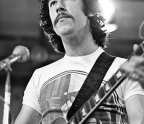
It’s quiet out here. Or it was. Canadian country singer Ronnie Hawkins’s estate looks out on to Stoney Lake, a geographical idyll in Peterborough County in central Ontario. The surface of the lake is glassy and dark and so flat it looks like you could step on to it and walk to the furthest shore.
A dark wooden barn sits back on the property, away from the main house with its bay window looking out towards the serrated edges of fir trees that sit jaggedly against the sky. The barn rattles and hums at all hours of the day, and sometimes night. The frenetic writing sessions taking place inside fizz and fade as the orange burns out of the August afternoons. Although the keening guitars, rumbling bass and headspinning drum parts aren’t the cause of consternation for the birds dotted among the woods this afternoon, it’s the strange, relentless engine hum overhead, a darting blur of propellor blades and a small engine that sounds like it might choke, stutter and disappear out of sight at any moment.
“Alex [Lifeson] was in the heat of his ‘model aeroplane period’ at that point,” says Geddy Lee, making inverted commas in the air with both fingers, faux-exasperated with eyebrows arching upwards. “Even Broon [producer Terry Brown] had the stupidest aeroplane you’ve ever seen in your life.”
“I like to have a hobby when we’re working,” Lifeson says.
Lifeson is grinning like he’s still got that model aeroplane tucked under one arm and is heading to a vantage point to send it into the sky. “I had a radio-controlled plane that I built there and crashed into the top of a truck,” he recalls. “Might have been Broon’s truck? Bang, right into the top of the cab, put a hole in the roof. But you should have seen the plane that Terry had. It was on these lines, and you flew it in circles, I guess. And the engine on it was probably twelve thousand horsepower, and it went, like, nine hundred miles an hour – but in a circle.”
Lee: “It was going around and around, getting faster and faster, and Terry was holding on to it and getting dizzier and dizzier…”
Lifeson: “And he had to let go of it. He was going around and around, and I was laughing so much that I had to lay down in the grass. There were literally tears in my eyes.”
Lee: “I was standing not too far from him. And when the thing took off I had to hit the deck! This plane whizzing around overhead tethered to Broon – I mean, it had to come down eventually. He could barely stay upright. It was great. They were fun writing sessions, a good head-space.”
Lifeson: “As long as you weren’t being hit in the head by, you know, Broon’s or my plane…”
Welcome to the writing sessions for an album that would help define not only Rush, but also rock music in the early 80s: Moving Pictures.

It’s 2022, and Alex Lifeson and Geddy Lee are siting in their respective homes in Toronto, the city in which they met as gawky kids with ambitions of being in a band. Lee is in his living room, Lifeson in his home studio, the wall behind him hung with guitars. Even on a Zoom call, the sparky energy that has kept them as friends and bandmates for more than 40 years is still evident. They are, at turns, reflective, forgetful, deeply focused or simply goofy when it comes to recalling those summer writing stints – and autumn and winter recording sessions – that resulted in a record that would help propel them to platinum rock-star status, and dominate their live sets until Rush finally retired in 2015.
It will give readers some idea of the hectic writing, recording and touring schedule that the band were undergoing at that point in their career to know that it was straight after they’d finished writing for that they packed up their equipment, rescued Lifeson’s




